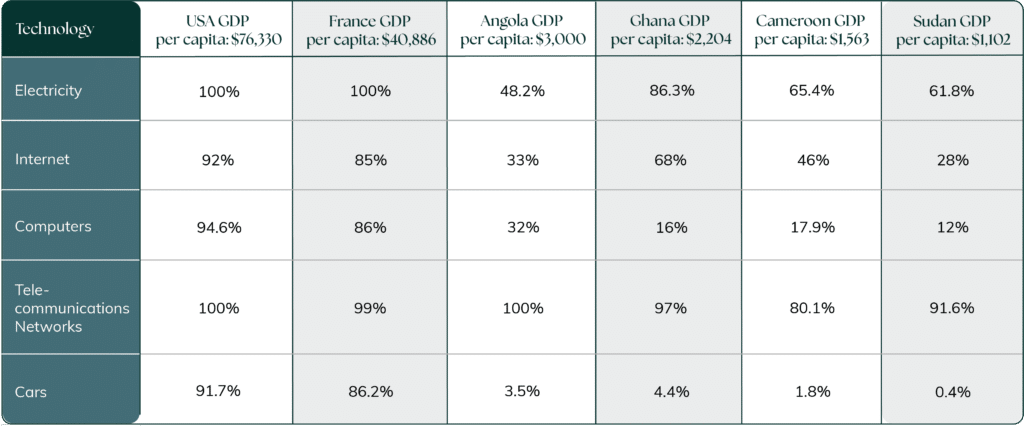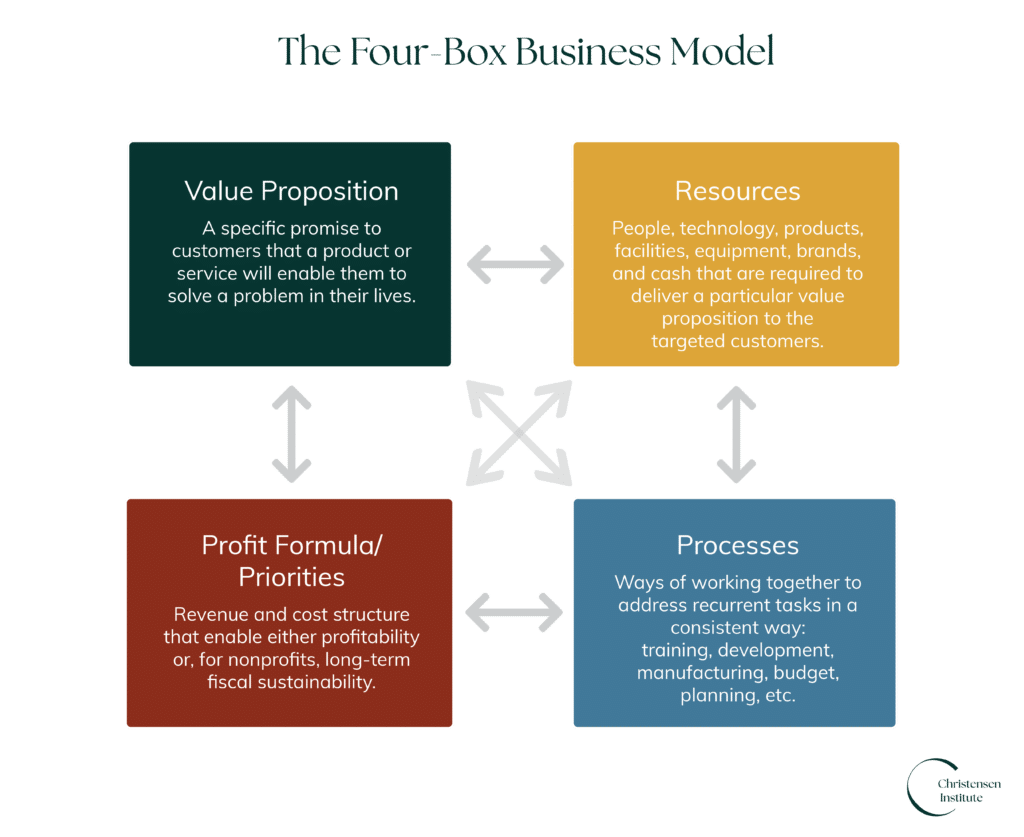In part 1 of this piece, we examined how innovators can look to historical precedent to better understand the potential challenges in leveraging AI toward global prosperity, specifically, hurdles associated with safety and democratization. Democratization is no easy feat, however, and after understanding the market-creation process that can lead to access for all, it’s now time to understand why the business models wrapped around a technology, like AI, factor so critically within the market-creation process toward prosperity.
But first, let’s take a step back and examine what’s currently happening with AI and business models.
Generative Artificial Intelligence (GenAI) is the branch of artificial intelligence focused on autonomously creating new content, including images, music, text, videos, and even novel molecular structures. It works by analyzing vast amounts of existing data and identifying patterns within it. This capability has significant implications, as many now see GenAI as a general purpose technology (GPT) that has the potential to fundamentally transform how the world works. When we describe AI in this piece, we are referring to GenAI.
GPTs often cut across industries and sectors and serve as the infrastructural base upon which many other products and services are developed. Some examples of GPTs are electricity, the steam engine, the internal combustion engine, and, recently, the internet.
Understandably, there is high excitement about AI’s potential to fuel global prosperity, as the technology is already having an impact on healthcare, finance, agriculture, and other sectors.
In healthcare, AI is used to assist in medical diagnosis, predict patient outcomes, and personalize treatment plans. In the US, for example, AiCure, is a platform leveraged in medical trials to remotely collect patients’ physiological and behavioral data. The mobile application helps pharmaceutical and biotech companies monitor medication adherence, patient behavior, and develop insights that would otherwise only be possible through direct visualization of patients. In India, NIRAMAI has developed a breast cancer screening test, Thermalytix, which leverages AI to analyze thermal images for the early detection of breast cancer.
In finance, AI can be leveraged for fraud detection, trading, risk assessment, and market analysis. In China, Ant Group, an affiliate of Alibaba Group, uses AI for various services, including digital banking, credit scoring, wealth management, and risk assessment. Another example is Wealthfront in the US, which uses AI algorithms to manage investment portfolios for clients.
Many examples continue across sectors like agriculture and transportation, and they illustrate AI’s incredible potential.
But for AI to transform the lives of the poor, the technology needs to be embedded into a business model targeted at nonconsumers globally.
Consider the adoption of other technologies globally. In most high-income countries, the technologies are accessible to the vast majority of the population. In low-income countries, access is often limited to the wealthy. Although these technologies have significant potential to solve problems for billions of people, most of them have not been incorporated into business models targeted at the world’s nonconsumers.
Diffusion of different technologies in select countries

- Sources:
- https://data.worldbank.org/indicator
- https://prosperitydata360.worldbank.org/en/indicator/ITU+DDD+30
- https://www.ibisworld.com/us/bed/percentage-of-households-with-at-least-one-computer/4068
- https://www.statista.com/statistics/1244250/share-computer-household-france
- https://www.itu.int/en/ITU-D/Statistics/Dashboards/Pages/Digital-Development.aspx
- https://datahub.itu.int/data
- https://www.forbes.com/advisor/car-insurance/car-ownership-statistics
- https://www.onisr.securite-routiere.gouv.fr/sites/default/files/2022-12/74-75%20Household%20car%20fleet%20V5_0.pdf
- https://en.wikipedia.org/wiki/List_of_countries_and_territories_by_motor_vehicles_per_capita
As the table highlights, except for telecommunications services, most technologies are primarily available to people in high-income countries. If AI follows the same path, it would limit AI’s impact and, most importantly, its benefits. In a worst-case scenario, depending on how companies leverage AI, it could destroy tens of millions of jobs in low- and middle-income countries. For instance, consider customer service jobs being outsourced to AI agents. This could significantly affect countries such as India, Malaysia, and the Philippines. As the technology improves, more companies will adopt it to reduce cost, increase productivity, and enhance their competitive advantage in the market.
The goal, however, shouldn’t be to force AI into a context where most people aren’t ready to absorb it, similar to many other GPT investments such as electricity, Internet, and computers. Instead, the goal should be to first identify a specific need or desire experienced by nonconsumers and then develop a business model that solves for the need or desire.
The four components of a business model
Many AI solutions today aren’t embedded into business models focused on global nonconsumers. For companies to successfully target nonconsumption, they must first understand a business model and how it impacts their strategy.
An organization’s business model consists of four interlocking, interdependent elements that can create and deliver value. As detailed in our video, each of these elements works together, and a change in one element indicates a change in another element. The four elements of a business model are value proposition, resources, processes, and profit formula.
Value Proposition: A business model typically starts with products or services that help customers accomplish something more effectively, conveniently, and affordably. In short, it provides a solution. If a value proposition helps customers do something they’re not trying to do—even if they should be trying to—the business model won’t be viable.
Resources: Resources include people, technology, intellectual property, products, suppliers, distribution channels, equipment, facilities, brands, and cash. They are the most tangible of the four components and can be most easily obtained or released.
Processes: Processes are the ways a company has learned to use its resources. They are often embedded in a way that an organization, at one point in time, found successful in solving a problem. Some processes come about as a company uses its resources to deliver the value proposition. Others are habitual ways of working that have evolved over time in response to recurrent tasks. When processes have been used successfully and repeatedly, they become assumptions rather than explicit decisions.
Profit Formula: The profit formula defines the gross and net margins the organization must achieve, given the structure and magnitude of the fixed and variable costs inherent in its resources. This ultimately defines how big an opportunity must get for it to be attractive to people in the company. In general, the profit formula defines value for the company and its owners, and the value proposition defines value for the customer.
The business model framework (download here)

The arrows in this graphic are bidirectional because the sequence in which the four boxes of the business model are assembled typically varies by circumstance.
It is important to recognize that AI is simply a technology, albeit one with incredible potential. As such, it resides in the resources component of the Business Model framework. What will matter is how investors and entrepreneurs choose to incorporate the technology into their organization’s business model to serve nonconsumers globally.
Why targeting nonconsumption is a successful business model
The adoption and proliferation of mobile telecommunications in most growth economies illustrate just how successful it can be for innovators to develop business models targeting nonconsumers in growth economies.
In the late 1990s, fewer than 5% of the African population had access to mobile phones. Like cars during Henry Ford’s time, mobile phones were affordable only to the wealthy. However, in 1998, Mo Ibrahim founded Celtel, introducing a business model that made affordable mobile phones and telecommunications services accessible across multiple African countries. Ibrahim had to design, build, and operate the telecommunications infrastructure for African nonconsumers to do that.
Here’s how he put it: “In Africa, we needed to make [mobile phones] available right away to very poor consumers. Our customers wouldn’t have access to the kind of money that Westerners paid for monthly mobile contracts. So we created better options for each market…” In building the infrastructure, he noted that, “We had to use helicopters to move our base stations and take heavy equipment up a hill or into the middle of nowhere. We also had to figure out how to get power to those spots. Building anything in sub-Saharan Africa is a really tough task. We had to supply our own electricity and our own water. We had to refill our generators and replenish our batteries every day.”
Despite these unconventional challenges, the focus on nonconsumers paid off handsomely for Ibrahim and for Africa.
Within six years, Celtel expanded to 13 African nations, amassing 5.2 million customers and generating $614 million in revenue. Ibrahim sold the company in 2005 for $3.4 billion. Celtel’s success, and that of a few other telecommunications companies, catalyzed the growth of Africa’s mobile telecommunications industry, which spawned more than 100 operators from just a handful. Today, this sector sustains over three million direct and indirect jobs, contributes nearly $20 billion in annual taxes, and adds an estimated $170 billion in economic value to the continent, according to GSMA.
Today, mobile telecommunications has perhaps become the most widely adopted technology globally. It can be found in both rich and poor countries alike, and with both wealthy individuals and those with less means.
Like mobile telecommunication, AI has significant potential to create global prosperity. But the same principle applies to scale in a way that proves profitable and provides equal access globally—the technology must target nonconsumption.
Five considerations on AI and global prosperity
In part 1 of this piece, we began with the quote:
“Nothing has been written on this topic which can be considered as decisive–and accordingly, we find everywhere men of mechanical genius, of great general acuteness and discriminative understanding, who make no scruple in pronouncing the Automation a pure machine, unconnected with human agency in its movements, and consequently, beyond all comparison, the most astonishing of the inventions of mankind.”
Edgar Allan Poe, “Maelzel’s Chess Player,” 1836 (italics in original)
In contrast to Maelzel’s Chess Player, where a concealed human controls the game, artificial intelligence operates independently, and the technology continues to improve daily. However, much like Poe’s narrative, human influence remains critical in steering the trajectory of this technology—determining its societal implications and potential for global prosperity. In effect, we still hold the chess pieces. Quoting Kristalina Georgieva, the Managing Director of the IMF, “The AI era is upon us, and it is still within our power to ensure it brings prosperity for all.”
In helping answer this call-to-action to ensure AI brings prosperity for all, here are five considerations for entrepreneurs, innovators, policymakers, and thought leaders based on the insights from our two-part piece:
1. Consider critical guardrails
Historical precedent around the introduction of powerful business models enabled by new technologies too often proves that innovation without regulation or oversight can result in negative consequences for those poised to reap the most benefits.
In an effort to better ensure the safety and security of its citizenry and markets, governments, agencies, and organizations would do well to introduce iterative guardrails intended to help scale AI toward its most positive, impactful potential to spur global prosperity.
2. Don’t dismiss democratization
In their book, Power and Progress: Our 1,000-Year Struggle Over Technology and Prosperity, Acemoglu and Johnson note that “there is nothing automatic about the ‘progress’ part of technological progress.” Technology is agnostic to the impact it has on people’s lives. Prosperity, on the other hand, is about people. When a technology is positioned to create prosperity, questions like these should be asked: Who has access? What does this access afford them? Are people’s lives better today than they were yesterday? What externalities are created by this technology, and what impact will it have on people?
Because of AI’s immense potential, it’s never been more important to double-down on democratization.
3. Understand the distinction between innovation and market-creating innovations
An innovation is any new product, service, or way of doing something. An innovation could mean a new way of extracting water from the ground in order to serve people in a poor community. But what if the people are unable to sustain this technology? What if the new technology is only accessible to those who have the resources to get to the well? If the innovation is implemented devoid of context or circumstances, it may simply be abandoned or widen disparities. In short, it won’t be sustainable.
However, market-creating innovations have a unique three-phase process, dependent upon identifying context specifics and democratizing access. For AI to create prosperity, it must be wrapped in a business model that adheres to the three phases of market creation.
4. Recognize AI as a technology, not a business model
As noted above, AI is a resource that will ultimately serve a value proposition. If the business model’s value proposition seeks only to serve the most privileged or doesn’t take into account the needs or desires a large number of people are currently experiencing or seeking, AI won’t have the transformative power many evangelists tout.
5. Realize that AI’s business models must target nonconsumption
If specific efforts are not made to focus the business model on nonconsumption globally, not only will AI have little positive impact on the poor, but it will also widen opportunity gaps and increase inequalities.
Directing AI to solve nonconsumption challenges goes beyond the technology to build out the necessary infrastructure required by the business model. Thus, a company’s resources, processes, and profit formula must be tightly aligned to solve a nonconsumer’s need or desire.
Bonus: AI should enhance skills, not simply eliminate jobs
In their research, Dimitris Papanikolaou and Bryan Seegmiller of the Kellogg School of Management at Northwestern University describe who wins and who loses when new technologies arrive. And why it happens.
Their paper suggests that “AI, as a technology, levels the playing field within an occupation.” When AI can augment the skills of people, it will lead to higher wages. However, when it replaces tasks, it will lead to lower wages. As such, there should be a concerted effort to use AI to enhance the skills of workers, especially those in growth economies.
For example, in education, AI can support teachers in several ways, from lesson planning to professional development. Squirrel AI Learning is a Chinese edtech company specializing in adaptive education. Their technology helps teachers and students by analyzing student data, recommending teaching strategies, and offering tailored resources to help educators enhance their instructional practices. However, AI shouldn’t replace teaching.
In health care, companies such as Osso VR leverage AI to train and assess health care professionals with surgical simulators and virtual reality, allowing workers to practice procedures, refine their skills, and improve patient safety in a risk-free environment. Companies in growth economies can and should similarly leverage AI to augment the skills of their workers rather than using the technology as a mostly labor-saving resource designed to replace workers.
Because AI is a nascent technology with implications we may not yet comprehend, we offer these pieces as introductory reflections aimed at spurring conversation and questions. In this spirit, we’d love to hear from you: what do you think are critical considerations around AI for global prosperity? What are the challenges entrepreneurs and innovators face or may be facing? Let us know—we’d love to hear from you!




